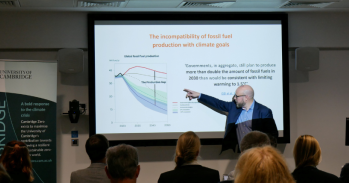
Replacing housing association homes sold under the new Right to Buy scheme with those for sale could drive up costs for low-income tenants and the taxpayer, according to a new report.
Replacing housing association homes sold under the new Right to Buy scheme with those for sale could drive up costs for low-income tenants and the taxpayer, according to a new report.
The research has shown that the rent level of replacement stock is critical. Replacement homes for sale or shared ownership will not be affordable to those seeking social rented housing
Anna Clarke
The new analysis, recently published by the Joseph Rowntree Foundation (JRF) and conducted by researchers at the Cambridge Centre for Housing and Planning Research (CCHPR) in the Department of Land Economy, is the first to look at the impact of building replacements homes as shared ownership.
The report, Understanding the likely poverty impacts of the extension of Right to Buy to housing association tenants, estimates that there will be 75,000 fewer low-cost homes becoming available to let over the next 5 years if the homes built to replace those sold are available as shared ownership rather than as low-cost rentals.
Taking into account the incomes of social tenants, the affordability of homes and the take-up rate of Right to Buy (RTB) by council tenants, researchers predict that 128,000 Housing Association tenants are likely to buy their homes under RTB over the next 5 years – fewer than one in 10 of all tenants.
The research shows that there are currently around 180,000 housing association tenants who could afford to exercise their RTB. Around half of these will be required to pay higher rents under the Governments new Pay to Stay scheme, and the higher rents they will face are likely to encourage them to buy their homes if possible.
The policy will have a huge impact on people who need to access low cost rented homes in the future, say the JRF. Building replacement homes for sale as shared ownership will mean that people seeking a social rented home will be pushed into the bottom end of the private rented sector, where homes are typically more expensive, less secure and in worse condition than Housing Association homes. The report finds that over the next five years if replacement homes are built for sale:
- 62,000 tenants will have to find an average of £1,668 extra a year to pay private rent. Around a third of these households are paying their rent themselves from their generally low earnings.
- The other two thirds are in receipt of housing benefit, meaning that £31 million will be added onto the housing benefit bill as more people who claim housing benefit are pushed into the more expensive private rented sector or remain longer in homeless accommodation.
- Just three percent of new social tenants could afford to buy the replacement properties if they were available as shared ownership.
In contrast, if the homes are built back at the same rent levels as those lost, there is only a temporary loss of lettings – caused by the delay whilst replacement housing is built. Under this scenario the estimated housing benefit costs of the policy fall to around £16 million and the increase numbers renting privately or in homeless accommodation is close to zero by the end of five years. The number of available lettings will increase after five years as new rented homes continue to be built.
The replacement homes will be funded by the sale of high-value council homes, likely to be classified as homes that are valued in the top third regionally. Local Authorities have different proportions of high value housing stock, meaning that some face losing a large amount of their social housing, while others will be forced to sell very little, or own none to start with. The five worst affected areas are all in the London commuter belt, and face losing more than half of all their low-cost lettings.
“The research has shown that the rent level of replacement stock is critical. Replacement homes for sale or shared ownership will not be affordable to those seeking social rented housing,” said Anna Clarke, Senior Research Associate at CCHPR.
“Replacement on a like-for-like basis could have a positive impact on the availability of social lettings, over the next five to ten years, though in the long term the subsidy for Right-to-Buy discounts cannot forever be found by selling off high value council stock without continually stretching the definition of high value,” she said.
Julia Unwin, Chief Executive of the JRF, said that this research shows how important it is to keep up the numbers of genuinely affordable rented homes.
“To make sure that this policy doesn’t drive up poverty in the long term, the Government must ensure that every low-rent home sold is replaced by another of the same tenure, same cost and same locality,” said Unwin.
Adapted from a Joseph Rowntree Foundation press release.

The text in this work is licensed under a Creative Commons Attribution 4.0 International License. For image use please see separate credits above.




